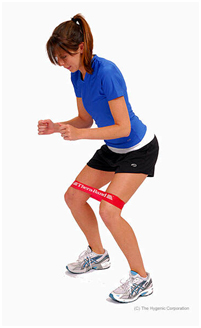Patello femoral knee pain is one of the most common causes of knee pain in the adult and adolescent population. It results from the knee cap (patella) not tracking properly within the groove where it sits and and therefore causing pain when you bend your knee during certain actvities.
Whilst it is a very easy problem to diagnose, fixing it can be a bit more complex due to multiple contributing factors. Some of these can include:
– tight muscles eg quadriceps, hamstring calf, Iliotibial band
– weak muscles (quadriceps, gluts, calf)
– poor foot biomechanics egoverpronated (flat) feet
– bonyabnormaltieseg shallow groove or wider pelvis

There are certain activities which will tend to aggravate knee pain in people with PFJ. These can include:
– stairs
– squats
– lunges
– walking or running
– hills/ up or down
– sitting for long periods
How can you manage your symptoms?:
Once your physiotherapist has diagnosed your problem they should have an idea which of the contributing factors is most responsible for your pain.
Initially you may be given stretches to complete regularly to lengthen out your muscles. It’s important that any stretching you do does not reproduce your pain, so you may need to adjust your stretching technique slightly. Regular massage or dry needling/ acupuncture can also be helpful in loosening tight muscles. Using a foam roller can also be great for loosening up your muscles particularly the iliotibial band (down the side of your leg).
If your foot biomechanics are thought to be contributing to the problem your physiotherapist may refer you to go and see a podiatrist. You may then need to buy new footwear with better arch support or you might need orthotics to stop your arch flattening too much. It’s important to remember most runners will only last 700-800km so if you are a keen runner these do need to be changed regularly. You can often still wear your old runners for walking/ casual wear although check with your physio/ podiatrist first.
Tapingor using a brace to keep your kneecap in good alignment is a short term solution that physios often use to allow you to keep up your regular activities whilst minimizing the pain. Yourphysio should be able to show you how to self tape and we usually use this technique until the muscles are strong enough to do the same job as the tape does.
Strengthening exercises: – These will vary depending on your assessment but most people will need to strengthen at the very least the gluteal ( buttock ) and quadriceps muscles. There are specific levels of progression in terms of how hard the muscle is working that you need to perform to get back to full strength.
How long does it take to get better?
Depending on how long you have had the problem for and how many contributing factors are involved will depend on your recovery time, but it can often be a number of weeks to months before you are back to full activities without any pain.
Avoiding aggravating activities– if there are certain activities that you know make your pain worse then it is important to modify them or try alterative forms of exercise that place less stress on the knee eg cross trainer, swimming or exercise bike. Also remember that certain activities can also affect your pain such as wearing high heels or ballet flats for long periods
Flare ups
As full recovery can take a while most people will overdo it and flare up their knee pain at some stage in the recovery process.
If your knee pain does flare up try using ice, taping and if required anti-inflammatories to settle it down. You may often need to see your physio again to progress your exercises as you improve.
If you have any more questions please feel free to contact the team at Leap Back Physio. www.bounceback-physio.com.auph 03 90772206

